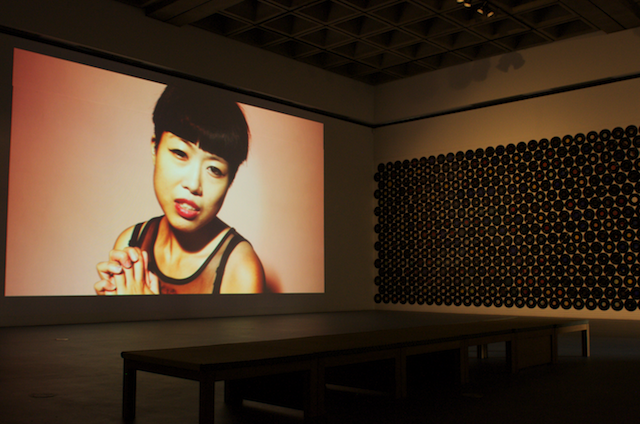Japanese American Cultural & Community Center (JACCC), Los Angeles, 26 February – 2 April
As a musical genre, enka originally sprung up in Meiji-period Japan as a way to circumvent censorship of dissent by setting political speech to music; in the postwar years however it has mainly come to be known as a medium for sentimental ballads. For this exhibition, Los Angeles-based Bruce Yonemoto has worked with a range of artists from both sides of the Pacific to reimagine the potential of this plaintive form.
For the original installation of ENKA! (2015-), as part of An Asia Survey, Yonemoto’s 2015 exhibition at the Hong-Gah Museum in Taipei, he worked with Taipei-based artists Yin-Ju Chen, James T. Hong, Huang Dawang and Teng Chao-Ming to rewrite the lyrics to Mother, Please Take Care of Yourself (1960). Each artist revisited this well-known Taiwanese pop melody, updating the lyrics to reflect current issues, whether they be tensions between China and Taiwan or the plight of protesters. For the present exhibition, Yonemoto took the opportunity to supplement that work with a new song, written by fellow artist Koki Tanaka (who recently moved back to Japan from Los Angeles) and adapted from the 1960s hit Karajishi Botan, popularised by the movie star Takakura Ken. The original takes its title from the Guardian Lion and Peony motif tattoo commonly associated with yakuza, with the words outlining the thoughts of a gangster reflecting, stoically, on his life. Tanaka’s take, while maintaining the refrain of the title, turns the song into a commentary on Japanese and US relations, explicitly calling out, for example, Prime Minister Shinzo Abe’s contact with President Donald Trump.
Although the audio tracks hew to the (geo)political, the image of the singers themselves tells a somewhat different story. The videos are shot simply, with each person set against a different coloured backdrop, with the camera mostly close up, but zooming in and out at various points. As the title of the exhibition suggests, the performances by Betty Apple, Taro Hattori, Ray Hsu, Kaz Oshiro, Yu Cheng-Ta and Huang Dawang himself (most of the lyricists did not sing their own songs) bring out in spades the kind of emoting familiar to anyone who has been to a karaoke bar. There is a delight in seeing how each singer comes to inhabit their song, adding their own style. Huang, for instance, engages in a kind of Keatonesque physical comedy that is a signature of his, while Yu chooses an altogether more Buddhalike route. This point is especially clear with Oshiro and Hattori, who offer up renditions of Tanaka’s lyrics so campily different from one another as to almost be unrecognisable as the same song. To watch these videos in Mandarin, Taiwanese and Japanese in the cavernous space of the JACCC, a few weeks after the inauguration of Trump, is to be reminded of how the political can also be very personal. And, as the wall of vintage 78-rpm records installed on a sidewall make clear, there is a lot more where that came from.
First published in the Summer 2017 issue of ArtReview Asia
